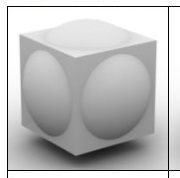Intriguing Ornament, Part II
At the home of a mathematician friend I noticed an unusual holiday ornament the other day that consists of a sphere within a concentric cube. It would have been inappropriate to take a picture under the circumstances, but , fortunately, I found a somewhat similar picture online (the ornament comes in more pleasing colours, of course). The host explained that the ornament is skillfully designed so that the areas of the exposed parts of the sphere and of the cube are exactly equal. Find the ratio between the radius of the sphere and the side length of the cube!
As your answer, submit , rounded to the nearest integer.
Suggested by Jeremy Galvagni

The answer is 633.
This section requires Javascript.
You are seeing this because something didn't load right. We suggest you, (a) try
refreshing the page, (b) enabling javascript if it is disabled on your browser and,
finally, (c)
loading the
non-javascript version of this page
. We're sorry about the hassle.
By symmetry, we may focus on one face of the cube. The surface area of a cap, 2 π R h = 2 π R ( R − 2 a ) , has to be equal to the area of a face of the cube, a 2 , minus the area of the disk covered up by the sphere, with radius R 2 − 4 a 2 , by Pythagoras. Thus we need to solve the equation 2 π R ( R − 2 a ) = a 2 − π ( R 2 − 4 a 2 ) . Division by a 2 produces the quadratic equation 2 π q ( q − 2 1 ) = 1 − π ( q 2 − 4 1 ) , with the relevant solution q = 6 1 + 9 1 + 3 π 1 ≈ 0 . 6 3 2 7 . The answer is 6 3 3 .